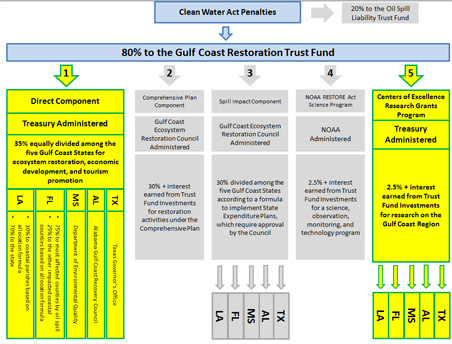On April 20, 2010, an explosion on the Deepwater Horizon oil rig drilling in the Gulf caused the largest offshore oil spill in the United States, exacerbating the effects of previous natural disasters. Oil flowed unchecked for three months. Before the well was capped, millions of barrels of crude oil were released, closing tens of thousands of square miles of Gulf waters to fishing and causing extensive damage to marine and wildlife habitats, and tourism.
On July 6, 2012, the President signed into law the Resources and Ecosystems Sustainability, Tourist Opportunities, and Revived Economies of the Gulf Coast States Act (RESTORE Act). The Act established the Gulf Coast Restoration Trust Fund in the U.S. Treasury Department. Eighty percent of all administrative and civil penalties paid after July 6, 2012, by responsible parties pursuant to a court order, negotiated settlement, or other instrument, under section 311 of the Federal Water Pollution Control Act in connection with the Deepwater Horizon oil spill are deposited into the Trust Fund and invested. Under the Act, amounts in the Trust Fund will be available for programs, projects, and activities that restore and protect the environment and economy of the Gulf Coast region. Treasury’s RESTORE Act final rule at 31 C.F.R. Part 34 became effective on February 12, 2016, and was later amended to include changes to 31 C.F.R. § 34.204 regarding limitations on administrative costs and expenses.
The Gulf Coast Restoration Trust Fund will be distributed in the following manner:

Thirty-five percent of the penalties paid into the Trust Fund are set aside for the Direct Component, which is administered by Treasury for eligible activities proposed by the States of Alabama, Mississippi, Texas, Louisiana, twenty Louisiana parishes, and twenty-three Florida counties. Thirty percent of the penalties, plus one-half of all interest earned on Trust Fund investments are set aside for the Comprehensive Plan Component, which is administered by the Gulf Coast Ecosystem Restoration Council (Council). The Council includes members from six Federal agencies or departments and the five Gulf Coast States, and directs those funds to projects and programs for the restoration of the Gulf Coast region, pursuant to a comprehensive plan approved by the Council. Under the Spill Impact Component, the Gulf Coast States can use thirty percent of the penalties in the Trust Fund for eligible activities pursuant to state expenditure plans approved by the Council. The remaining five percent of the penalties, plus one-half of all interest earned on Trust Fund investments, is divided equally between the NOAA RESTORE Act Science Program administered by the National Oceanic and Atmospheric Administration in the Department of Commerce, and the Centers of Excellence Research Grants Program administered by Treasury.
The Treasury Inspector General is authorized to conduct, supervise, and coordinate audits and investigations of projects, programs, and activities funded under the Act.
Note: Requests for reasonable accommodations under Section 504 of the Rehabilitation Act should be directed to Ms. Marcia Small Bowman, Office of Civil Rights and Equal Employment Opportunity (OCRE), U.S. Department of the Treasury, at marcia.smallbowman@treasury.gov.
